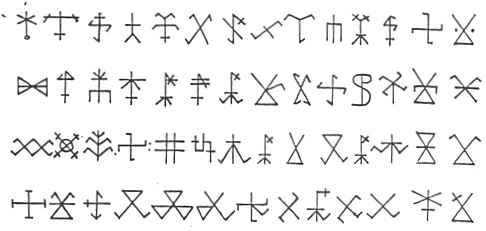By Jo Anne Sadler - 2007
Property Marks in Rural Norway - Bumerker
This article was written by Jo Anne for the Yearbook of the Tronderlag
of America, Norskbok Press, Ann Arbor, Michigan, about Bumerker. Most people will run across these property marks at some stage when doing Norwegian genealogy:
Bumerker (plural) were used as property marks before people could read and write. The practice was believed to have been in use by the Viking age and the early marks were based on the ancient Runic alphabet. They were used to show ownership of property and as the official signature of people who could not write their name. The mark was carved on homes, household goods, farm buildings, equipment, timber and barrels of trade goods. To sign documents, generally a seal stamp or signet ring (segler) was made.
What Bumerker are not are Coats of Arms or Family crests. The use of these were restricted to royalty, nobility, state officials and the upper classes.
The age of this practice is not known but there are identifiable bumerker from the early 1500’s. A Bumerke was the sign of each family and unlike the farm name; the bumerke mark went with the family. On large farm estates with several different cotters and husmann living on one farm, there would be a separate bumerke mark for each family.
Other names for bumerker were house marks and branding marks. Iron animal brands were called brennmerker and svinmerker.
Bumerker involved as time passed and became more complex. The early Runic symbols were adapted from the Latin alphabet into very simple straight lines in order to make the characters easy to carve on wood. Later, variations of the cross, international symbols such as the swastika, pentagram and hexagram appear. Pentagrams were believed to be magical and were used on buildings as protection against evil. As people learned how to read and write, initials were added. Variations of arrow, forks, hooks, chevrons, bows are some of the many symbols used. A common form was a circle or rectangle with initials and/or a symbol inside. The cross form occurs over and over.
Since a bumerke was a personal mark, when a man died it usually did not pass to his descendants. However, a son’s mark was often similar to that of his father and brothers and would usually only vary by an additional line or initial.
To say it was the mark of an illiterate person is not entirely correct as literate people of authority, merchants, and priests would also use them as seals on documents.
Finding your ancestor’s Bumerke mark(s) is a wonderful addition to your family history. There are many possibilities for use, stationery, stamp, signet (segler) ring.
Very few marks remain on farms as most homes and farm buildings have been replaced with modern structures. Bumerke symbols are listed in the back of many older Bygedebok books. The more recently issued Bygedebok books that I have seen do not contain the marks. Documents in archives, parish records, furniture marks, tombstones, local Norwegian Historical Societies and Folk Museums are all sources of information.

Some examples of bumerker
Einar Haugen Norwegian-English Dictionary:
Bumerke – mark used as signature by an illiterate person.
Norwegian-American Dictionary by Otto Jørgenson:
Bumerke - branding mark, branding iron was used instead of signature, often by people that couldn't read. It was fully approved in official contracts, etc. Often carved out of wood, or made as a signet ring (seglar) to make wax impressions on a document.
Mc Laughlins Dictionary of the Danish-Norwegian-English Languages:
Bema/erke – to observe, mark, to note, to mark, to take notice of, to perceive, to discover.
Bu – old word for a settler or farmer
